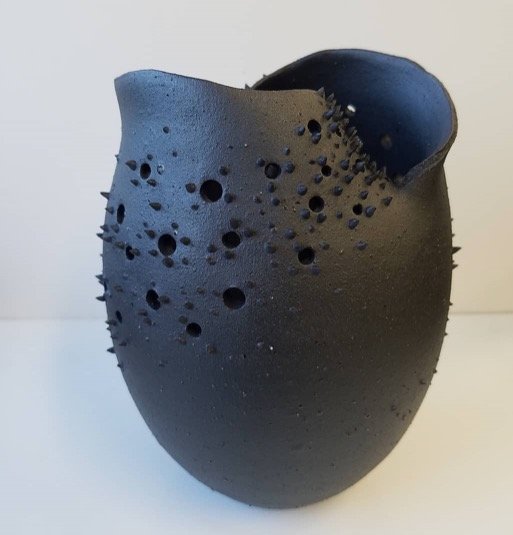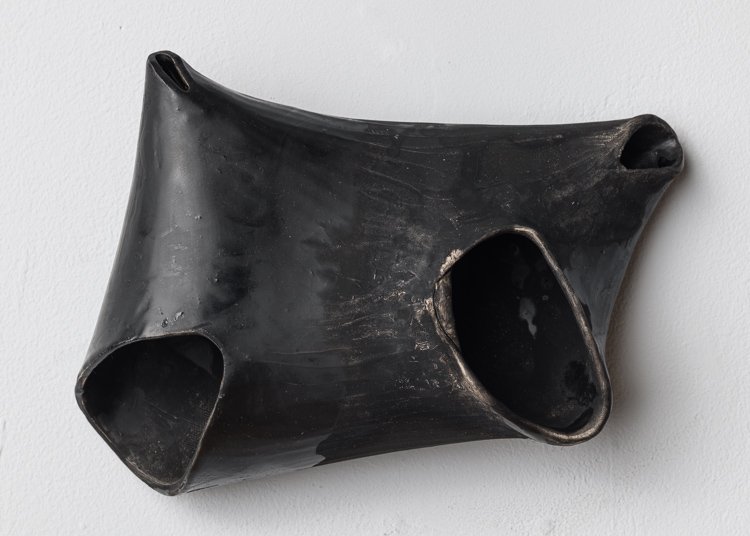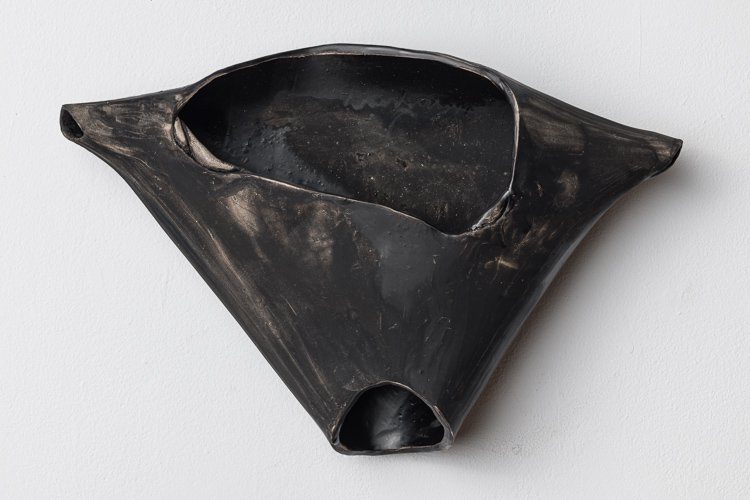“The ghosts swarm…
Each/has left something/undone.”
Bidden/
Unbidden
Unbidden
—Rae Armantrout
The ghosts swarm.
They speak as one
person. Each
loves you. Each
has left something
undone.
Did the palo verde
blush yellow
all at once?
Today's edges
are so sharp
they might cut
anything that moved.
•
The way a lost
word
will come back
unbidden.
You're not interested
in it now,
only
in knowing
where it's been.
“The ghosts swarm.” Armantrout’s unbidden—lost words and images, ghosts of beloved and ghosts of strangers—resurface in ceramic forms, sculpture, paintings, and poems.
Bidden/Unbidden showcases works of visual art by Carolyn Autenrieth, Rosalie Frankel, and Stephanie Hargrave, and poetry by Arlene Naganawa. In each work, ghosts appear, often surprising the artist. In Autenrieth’s ceramics, form and color create “a tolerable beauty” in response to deeply felt sorrow and loss. In Frankel’s rust-dyed, painted fabrics and canvases, lost souls appear spontaneously. These figures include grandparents she never knew, victims of the Holocaust, and other family members. She also responds to victims of racism. Hargrave’s piece, although she did not intentionally design it so, emerged as a figure of a friend who completed suicide.
The lines of poetry traverse the land of the living and the land of the dead, the living often grieving, the dead looking back, sometimes wistfully, sometimes sorrowfully, at their lives. The “lost word(s)” come back, both bidden and unbidden.
We Were Talking About When We Had Bodies
Meeting Inward
—Carolyn Autenrieth
Carolyn Autenrieth
Last October a friend and colleague took her life. The day I was given the news, it came as a thud, but somehow deep inside I already knew. The weight of teaching online, the despair of world events, so much heaviness. I had loaded my studio kiln the day before with some new black unglazed clay, so after school, with heavy feet, I routinely opened the kiln. As the pieces came into view, I recall words that seemed to rush forward when I saw the ceramic forms. "All light was sucked into the blackness, reflecting a beauty I could just tolerate." It was a powerful moment reflecting on her death, the death of another close friend earlier in the year, the darkness in our world... Was it the Holy Spirit? Was it my creative spirit? Was it the weariness of a terrible day within a terrible season? I don't know why or how those words came, but the impact was palpable.
I had not thought of 'death' or darkness in that way when creating the forms; rather the intention had been to explore a new aesthetic of contrast with this dark clay. Contrast is a large part of my work - the textures, and use of light and shadow. The next group of pieces were inspired by this reaction and the words that continued to haunt my mind. I wanted to explore more story of connection and contrast, of hope and loss through the textures and movement in the pieces. Bringing opposite aspects together, using the spikes and holes to migrate, to move the eye, and to reflect light in a tolerable beauty, became the work. All the pieces are wheel thrown and then in the 'leather hard' stage, are altered. When I cut or tear into the piece, I have an idea of what I want to do, but in the process I let the natural fall or curve of the clay speak to the final positioning. The clay has a language of its own, the natural curves, the waver, the fall, and as I work with it, I try to respond to this natural language.
The final piece, "Black Ribbon with pod" came together almost as an afterthought. I had several semi-translucent spiked pod forms and explored putting those with the deep black. In this piece, the pod seemed to feel nestled, as if in a nest, or protected under the ribbon waving above it. It seemed to feel like a new conversation was beginning to form.
Lily wilting like wet silk.
Candles listless and unbearable.
You protected yourself
and loved small.
—Arlene Naganawa, excerpt from “For the Queen of Kindness”
Reaching in a Barren Landscape
18.5” x 15.5”
Rusted cotton, beeswax, and acrylic ink
—Rosalie Frankel
Rosalie Frankel
My artwork is a unique mixed-media creative adventure. My practice usually starts with mark-making on fiber. I use various processes to alter fabric or paper by dyeing, painting, cutting, waxing, and/or rusting. I then engage in an exploration of the pieces I’ve created to find one that speaks to a feeling or idea I want to pursue.
Most of these current pieces started as fabric intentionally rusted to create unique patterns and shapes. This provided me with a good launching point to explore the themes I have been focusing on during this extended season of Covid. Rust was a good fit both symbolically and aesthetically.
It has been a difficult few years for all of us. I have been deeply impacted by the losses due to Covid, the political climate, and social injustice. I have also been drawn to exploring my personal history related to the Holocaust. Both of my parents are Holocaust survivors and although I was raised in a loving supportive home, the legacy of loss was an unmentioned presence. There was always an awareness of a void. I never knew anything about my grandparents or very little about my parents’ lives before they came to the United States. It was too painful to discuss so we focused on the present and the future.
While looking deeply at rusted fabrics, compositions and images emerged. I began to see figures related to my unknown history, along with other images related to ghosts and spirits. It was an interesting process because I didn’t create these images. I found them in random shapes and patterns of rust and then enhanced them with acrylic ink and wax so that the viewer could see them too. The pieces were not planned, they were found in the rust. Discovering these spirits and stories is a compelling journey.
No One Named a Constellation for You
No black river flecked with the memory of a hundred stars
speckle on trout, freckle, code etched deep in American soil
in creeks, blood, trees of bone forked in the heartland.
Your branch always the one crooked for the crow
new moon blacker than wind. No constellation
named after you, only a pattern of salt in your hand.
—Arlene Naganawa
NOLY (MORT)
Porcelain, Encaustic, Steel Wire
11″ h x 8″ w x 8″ d
Stephanie Hargrave
The Sculpture
I flew to Seattle from New York on September 15, 2019. The following day I learned that my most recent ex-boyfriend had hung himself that same travel day. His death was shocking to me, even though I knew he had been struggling incredibly with addiction for many years. The brutality of his passing sent me into a tailspin, as I hadn’t truly gotten past the end of the relationship, much less the demise of the man.
I ended up working obsessively on a sculpture, not knowing exactly why. I had many things to do, but was compelled to keep working in the cold studio, using porcelain and encaustic, wired with steel. It was only later, when I showed the work to my mentor, that it became obvious the sculpture was Jeff, hanging, head forward. It seemed a broken animal, pieced together, using both fragile and strong materials (porcelain and encaustic wired with steel). It was odd I hadn’t known what I was making until it was pointed out to me. It was clearly an exercise in soothing my pain—something I needed to do for my own comfort and understanding. I was paying homage to Jeff Nolan, and titled it his nickname: Noly.
We Were Talking About When We Had Bodies
Then sweet soup, melted crust and the broth,
a person we liked unfolding a napkin, each glance
like salt, hurricane lit from within.
Twigs and birds blown to the door…
Skin sliced on serrated edges, stitches like teeth,
like little mouths seared by fire, roughed by tongue.
Our fingers, keys, scraping. Bits of fractures.
Jewels sometimes fell from our hand
foxglove, windblown anemones.
—Arlene Naganawa
VENTER SERIES
Stephanie Hargrave
Bellies, pelvis bone openings, hollows, vessels, oldness, darkness, death, ghosts . . . these pieces came out of political unrest, raging racism, and Covid-19; time spent in Brooklyn New York experiencing the pandemic at that inner city level where the generators cooled extra containers holding bodies in the parking lots in the backs of the funeral homes and the street protests were loud. The weight of it all felt dense day and night.
These works came about then and felt about right with their references to bodies and bones. They are meant to honor the thousands we have lost. I think of them as objects of discontent - awkward in form, a bit like beautiful ghosts, slightly angry and frozen in a gesture of malaise.
Wood’s Spirit
22” x 28”
Rusted cotton and acrylic ink
Rosalie Frankel
The Hour Lies Like a Shroud Enveloping the Body Beneath It
-- to my mother’s mother, Kayo Hatsukano, b. 1890, d. 1935
Whitefish, Montana
This is not your body.
Another child, your seventh, floats
in the ship of your body.
Roll of waves under the berths.
Fish in the sea, eyes like coins.
Dark glaze of the Pacific.
Moths batter the windowpanes.
The moon rose like a face,
picture bride. Husband
a groaning steamship away.
Who thought this land
would be littered with wings?
They crumble in the dark
like bits of old leaves.
—Arlene Naganawa
Opposites Meet
—Carolyn Autenrieth
Luminous and remembered: shadows spilled on a riverbank
a pool of rain, stiff sparrow wrapped in white tissue, fist-sized gift left in the earth.
—Arlene Naganawa, excerpt from “The White Stones”
Grandmother Moon
18” x 14”
Rusted cotton and acrylic ink
Rosalie Frankel
I Weave a Nest of Foil
The night is sweet as powdered sugar, rotting porches.
I dream a bayou where cypress turn to firs.
The crescent moon is a jewel I drink in my chicory.
My hands glow at the moment of fortune.
Guns fire near my street, cries like confetti.
Gas light, ghost light. My bodies always disappear.
—Arlene Naganawa
Edge Reveal in Shadow
—Carolyn Autenrieth
The Heart
A door opened into her body, a cavern, pinpricks
like electric wasps.
Her fingers dimmed like fireflies
drained of light.
So this is someone’s work, she thought,
the dimpled spider and the white heal-all.
Her heart waned in the cave.
A fox crept to the mouth, lowered his head.
Wind shivered through her gown.
Where is he going? she asked.
Where is the spider? At night
flowers closed like ghosts on their stems,
moth wings ruined by fingers. Voices floated
from the hall, lungs filled and emptied,
avioli like paintbrush bracts,
like tips of lit torches.
—Arlene Naganawa
Pandemic/Holocaust
14” x 11”
Rusted cotton, Japanese paper, and acrylic ink
—Rosalie Frankel
Most Beautiful of Flowers
--Death toll, coronavirus, 2020
Hyacinth, upon whose petals were written
The rabbit, poisoned, rising to its small feet to meet the night
The white cloth, the still table
March 26, 2020
Note:
According to the usual version, Hyacinthus’ great beauty attracted the love of Apollo, who killed him accidentally while teaching him to throw the discus. Out of his blood there grew the flower called hyacinthos (perhaps a fritillary; not the modern hyacinth), the petals of which were marked with the mournful exclamation AI, AI (“Alas”).
—Arlene Naganawa
I Write to You in Isolation
--COVID time
Feb 19, 2021
Are you cold?
Numbers fall like rain-soaked leaves on river rocks.
A red thread tied around your finger—
the opposite of forgetting.
(How many ripples complete a pond?)
Ice on a bruised eyelid, scrim of frost on a glass door.
That was today’s time.
But chicks peck out under hens in my storybook.
We aren’t sick, not yet.
Do you feel them, the pick pick?
—Arlene Naganawa
Inner Meeting
—Carolyn Autenrieth
We wrote into each other’s lines
like sisters
our poems of other worlds.
—Arlene Naganawa, excerpt from “The Queen of Kindness”
Family Tree
20” x 30”
Rusted cotton and acrylic ink
—Rosalie Frankel
August
The sweet peas have broken into clouds.
How the flowers’ perfume rises
in the room, their fragrance vanity
perhaps or memory, cut blossoms
spilling from your mother’s hands.
How like the blood-red peony
she snapped from an abandoned yard,
garnet incongruity against her arms
dark with sun and work. How unlike
the mop and spatula, the hands
that pressed white blouses.
A childhood month, patch dug up
behind your house, one row each
of cat-faced pansies, carrots, jeweled
vines. Now your mother
comes again, waters the garden
with a can, pulls out
a morning glory vine.
How you plant and water.
How you want.
—Arlene Naganawa
BLM
30” x 15”
Cotton canvas, discharged cotton, acrylic ink and acrylics
—Rosalie Frankel
Sidewalk Altar
jars of peonies from the grocery
paper flags: George Floyd
Breonna
stones for prayers
the wind
a lying down of leaves
—Arlene Naganawa
Family and Bird
25” x 23”
Eco-dyed silk, beeswax, acrylic ink, and acrylics
—Rosalie Frankel
from Private Graveyard
Our mothers
weeded beds around blue hyacinth, spring
cleaning leaves of grief. Then dinner,
yeast rolls risen, sudsy washing up.
Rain fell on the graveyard. Up steps
to bed and lamplight, midnights.
Those days we loved all days—
new rain, shade of gravestones, steps
like bells, blue woods, our hyacinth spring up.
—Arlene Naganawa
This project was made possible by a CityArtist Grant in 2020
Acknowledgments and Appreciation
to the City of Seattle Office of Arts & Culture
to Rae Armantrout for "Unbidden" from Versed. Copyright © 2009 by Rae Armantrout. Used by permission of Wesleyan University Press. All rights reserved.
to visual artists Carolyn Autenrieth, Rosalie Frankel, Stephanie Hargrave
to photographer Julie Biggs for the photographs of Rosalie Frankel’s work
to photographer Paul Takeuchi for the photographs of Stephanie Hargrave’s work
to website consultants Meridian Smith and Lauren Ver Hage
to the following publications in which the poems originally appeared: Barnstorm, Crab Creek Review, Diner, Hummingbird, La Piccioletta Barca, The Inflectionist Review, The Seattle Review of Books, Private Graveyard (Gribble Press)
to the CC Writing Circle, The Dead Ringers, and Decasyllables for generously workshopping these poems


















